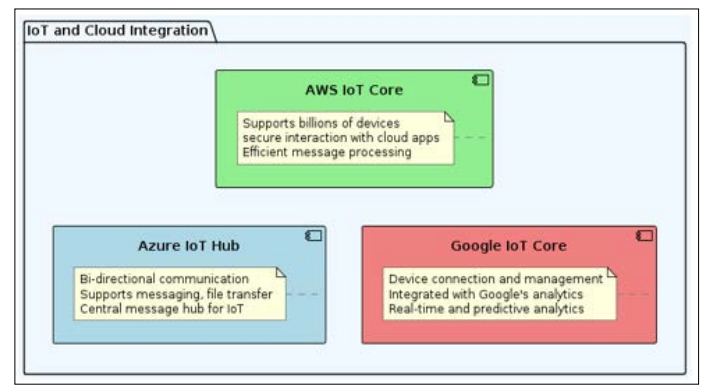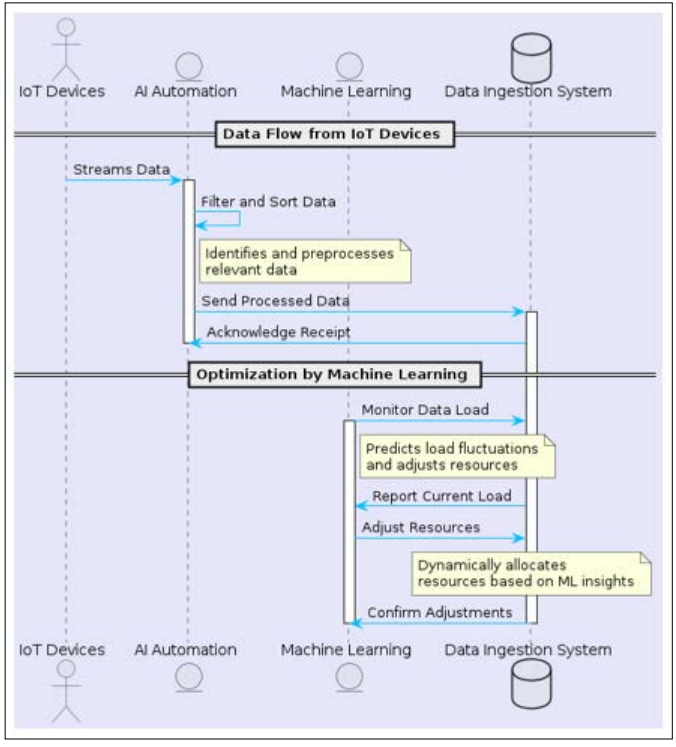Author(s): Sree Sandhya Kona* and Fasihuddin Mirza
The proliferation of Internet of Things (IoT) devices has ushered in an era where vast amounts of data are generated at the edge of network architectures, presenting both unprecedented challenges and opportunities for big data ingestion systems. This paper explores the complexities and strategic advantages associated with the integration of IoT data into big data platforms, highlighting how this convergence is reshaping business analytics and decision-making processes.
IoT devices, characterized by their ability to generate continuous streams of real-time data, pose significant challenges in terms of volume, velocity, and variety. The traditional data ingestion models are often inadequate to handle the scale and speed required for effective IoT integration. This necessitates the adoption of advanced data processing frameworks and architectures that can not only manage the high throughput of data but also accommodate the heterogeneous nature of IoT-generated information.
This analysis delves into several key areas: the technical challenges of IoT data management, including issues related to data volume, velocity, and variety; the role of modern data ingestion technologies such as Apache Kafka and Apache Storm, which facilitate real-time data processing; and the integration of cloud platforms like AWS IoT Core, Azure IoT Hub, and Google IoT Core that enhance the scalability and efficiency of data ingestion operations.
Moreover, the paper discusses the significant opportunities that arise from effective IoT and big data integration, such as enhanced real-time decision-making and predictive analytics, which can lead to improved operational efficiencies and competitive advantages in various industries including manufacturing, healthcare, and urban development.
In conclusion, while the integration of IoT with big data ingestion presents considerable challenges, it also offers substantial benefits for organizations looking to leverage deeper insights into their operations and markets. The paper provides actionable recommendations for businesses to navigate this complex landscape, ensuring they can capitalize on the full potential of IoT-driven data analytics.
In the contemporary landscape of digital transformation, the Internet of Things (IoT) has emerged as a pivotal force, driving an immense influx of data across multiple sectors. With billions of devices connected globally, IoT networks generate vast streams of real-time data, presenting both significant challenges and opportunities for big data ingestion frameworks. The effective integration of IoT data into these systems is crucial for leveraging its full potential, enhancing decision-making processes, and fostering innovative business solutions.
This paper explores the integration of IoT with big data ingestion, delving into the unique demands that IoT data imposes on existing architectural frameworks. Key challenges such as managing the high velocity, volume, and variety of data will be examined, alongside the need for robust, scalable, and efficient data processing solutions. We will discuss how advanced technologies like Apache Kafka and cloud platforms such as AWS IoT Core are instrumental in addressing these challenges, enabling more streamlined and effective data ingestion strategies.
By focusing on the integration issues and the transformative potential of combining IoT with big data platforms, this paper aims to provide insights into optimizing data ingestion processes to support real-time analytics and drive significant business outcomes in an increasingly connected world.
The integration of Internet of Things (IoT) data with big data platforms is pivotal for businesses looking to harness the real- time insights offered by the vast array of connected devices. This section delves into the inherent characteristics of IoT data and defines the process of big data ingestion, setting the stage for understanding the complexities involved in managing IoT data streams.
IoT devices are ubiquitous, from industrial sensors to personal wearables, each continuously generating data at an unprecedented scale and speed. The nature of IoT data is primarily defined by:
Big data ingestion involves collecting data from various sources, including IoT devices, and importing it into a system where it can be stored, processed, and analyzed. Key aspects of big data ingestion include:
Several big data platforms are optimized for IoT scenarios, including:
Understanding the characteristics of IoT data and the fundamentals of big data ingestion is crucial for developing systems that effectively handle real-time, diverse, and voluminous data streams. This foundational knowledge sets the stage for exploring more complex integration challenges and solutions in subsequent sections.
The integration of IoT data into big data systems presents several significant challenges that can impact the efficiency and functionality of data analytics platforms. The primary issues stem from the inherent characteristics of IoT data: volume, velocity, variety, and complexity.
IoT devices generate data at a scale and speed that can overwhelm traditional data management systems. The high volume of data, when combined with the need to process this data in real-time or near-real-time, poses significant challenges for data ingestion frameworks. For instance, in smart city applications, sensors across the city generate terabytes of data daily. Managing this data requires robust data ingestion systems that can handle high throughput efficiently without data loss.
IoT ecosystems are diverse, with devices that produce data in various formats—ranging from simple temperature readings in structured formats to complex video feeds and unstructured machine logs. This variety complicates data integration and processing as each data type may require different handling and analysis techniques.
In summary, while the integration of IoT with big data brings significant challenges related to volume, velocity, variety, and complexity, understanding these challenges and implementing strategic solutions such as using robust streaming platforms and standardizing data inputs are crucial for leveraging the full potential of IoT within big data frameworks.
To effectively address the challenges associated with integrating IoT data into big data systems, several advanced data processing frameworks and cloud solutions have been developed. These technologies are designed to handle large volumes of high-velocity data from diverse sources, offering scalability, fault tolerance, and real-time processing capabilities.
Technologies such as Apache Kafka and Apache Storm represent pivotal solutions for efficient IoT data ingestion.

Figure 1: Apache Kafka

Figure 2: Apache Storm
The use of these technologies provides substantial benefits in terms of scalability, allowing systems to grow and shrink dynamically based on the data load. They also offer excellent fault tolerance; both Kafka and Storm can handle node failures within the cluster without data loss. Lastly, their capability for real-time processing ensures that data ingested from IoT devices can be acted upon instantly, which is crucial for applications requiring immediate responses, such as in manufacturing or emergency services.
The integration of IoT with cloud platforms plays a critical role in streamlining the data ingestion process. Services like AWS IoT Core, Azure IoT Hub, and Google IoT Core offer specialized capabilities for IoT applications.

Figure 3: IoT and Cloud Integration
The advantages of using these cloud solutions include not only managed services that reduce the complexity of infrastructure management but also scalability and seamless integration with analytics tools. This combination enables businesses to focus on extracting value from their IoT data without being bogged down by the underlying systems management.
By leveraging both advanced data processing frameworks and cloud integration solutions, organizations can create robust, efficient, and scalable architectures for IoT data ingestion, ensuring that they are well-equipped to handle the demands of big data in the IoT era.
The integration of IoT with big data ingestion not only solves complex technical challenges but also opens up significant opportunities for businesses across various sectors. By enabling enhanced decision-making and predictive analytics, this integration drives operational efficiencies and strategic advantages.
Real-time data ingestion from IoT devices plays a pivotal role in enhancing decision-making processes. By providing immediate access to data as events occur, businesses can respond more quickly and effectively to dynamic conditions. This capability is especially crucial in environments where conditions change rapidly and decisions need to be data-driven to ensure optimal outcomes.
The combination of IoT data with big data analytics transforms maintenance strategies from reactive to predictive, providing significant cost savings and enhancing service reliability. Predictive maintenance leverages data from IoT devices to anticipate failures before they occur, allowing for timely maintenance that avoids the high costs associated with unplanned downtime.
These examples highlight how real-time data ingestion and predictive analytics create substantial business value, improving not just operational efficiencies but also driving innovations in service delivery and product quality. As organizations continue to harness the power of IoT and big data, the potential for transforming business operations and competitive landscapes increases significantly, underscoring the strategic importance of this technological integration.
As the integration of IoT with big data continues to evolve, emerging technologies and changing regulatory landscapes are shaping its future. This section explores the anticipated technological advancements and highlights the regulatory and security considerations that will influence how IoT data is managed and utilized.
The future of IoT and big data ingestion is poised for transformative changes, driven by advancements in AI and machine learning. These technologies are set to further automate and optimize the data ingestion process, enabling more sophisticated and efficient handling of the vast data streams generated by IoT devices.

Figure 4: Emerging Technologies
As IoT devices proliferate, generating an ever-increasing amount of data, concerns about data security and privacy are becoming more pronounced. Moreover, the regulatory landscape governing data use and protection is continuously evolving, posing additional challenges for organizations.
Overall, the future of integrating IoT with big data ingestion holds significant promise, facilitated by technological advancements and necessitating careful consideration of security and regulatory issues. Organizations that can navigate this complex environment effectively will unlock new potentials for innovation and competitive advantage, leveraging real-time insights to drive decisions and improve operations in ways previously unimaginable.
The integration of IoT with big data ingestion represents a pivotal evolution in how businesses harness technology to derive meaningful insights and make informed decisions. As explored throughout this discussion, the challenges posed by the sheer volume, velocity, and variety of data generated by IoT devices necessitate innovative solutions that can process and analyze data efficiently. The use of advanced frameworks like Apache Kafka and Apache Storm, along with cloud platforms such as AWS IoT Core, Azure IoT Hub, and Google IoT Core, has proven essential in managing these complexities effectively.
Looking ahead, the continuous advancements in AI and machine learning are set to further revolutionize this integration, enhancing automation and optimizing data ingestion processes to handle even greater scales of data. However, as technological capabilities expand, so do the challenges associated with data security and regulatory compliance. Navigating this landscape will require a proactive approach to implementing robust security measures and staying current with evolving regulations.
In conclusion, the integration of IoT with big data ingestion offers vast opportunities for businesses to improve operations, innovate services, and maintain competitive advantages. Organizations that strategically embrace these technologies, while also addressing the associated challenges, will be well-positioned to lead in the increasingly data-driven global marketplace [1-9].
